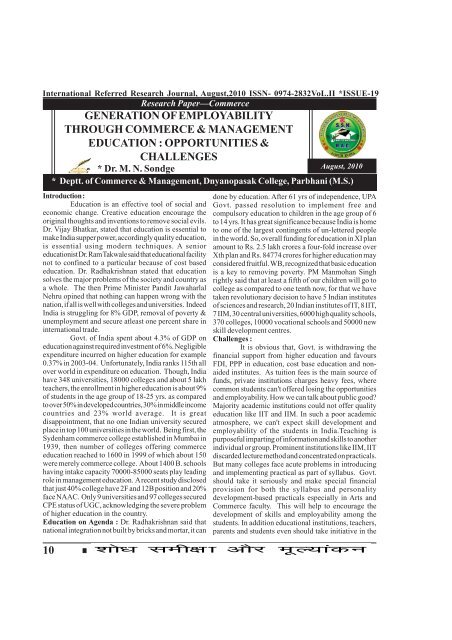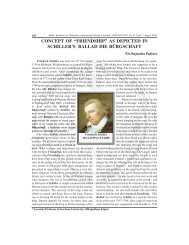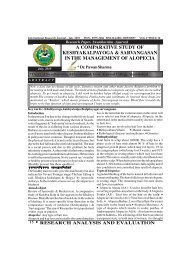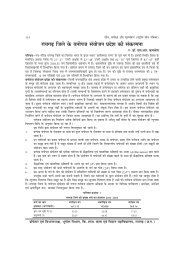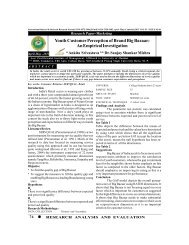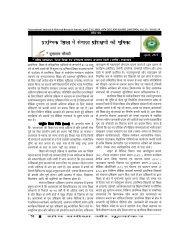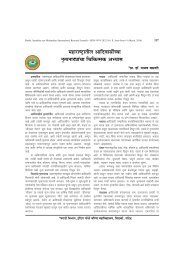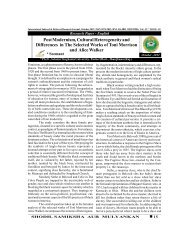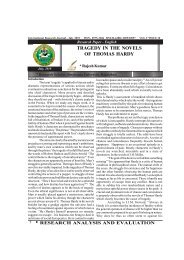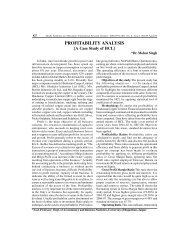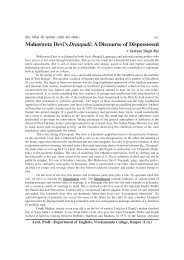UââU SÃâU â § ÃfllÃÃøÿà ¥ â§à ¬ÃâËUÿ-ââUªÃà Ãâ˧ÿÃâ¢Ã
UââU SÃâU â § ÃfllÃÃøÿà ¥ â§à ¬ÃâËUÿ-ââUªÃà Ãâ˧ÿÃâ¢Ã
UââU SÃâU â § ÃfllÃÃøÿà ¥ â§à ¬ÃâËUÿ-ââUªÃà Ãâ˧ÿÃâ¢Ã
You also want an ePaper? Increase the reach of your titles
YUMPU automatically turns print PDFs into web optimized ePapers that Google loves.
International Referred Research Journal, August,2010 ISSN- 0974-2832VoL.II *ISSUE-19<br />
Research Paper—Commerce<br />
GENERATION OF EMPLOYABILITY<br />
THROUGH COMMERCE & MANAGEMENT<br />
EDUCATION : OPPORTUNITIES &<br />
CHALLENGES<br />
* Dr. M. N. Sondge<br />
* Deptt. of Commerce & Management, Dnyanopasak College, Parbhani (M.S.)<br />
Introduction :<br />
Education is an effective tool of social and<br />
economic change. Creative education encourage the<br />
original thoughts and inventions to remove social evils.<br />
Dr. Vijay Bhatkar, stated that education is essential to<br />
make India supper power, accordingly quality education,<br />
is essential using modern techniques. A senior<br />
educationist Dr. Ram Takwale said that educational facility<br />
not to confined to a particular because of cost based<br />
education. Dr. Radhakrishnan stated that education<br />
solves the major problems of the society and country as<br />
a whole. The then Prime Minister Pandit Jawaharlal<br />
Nehru opined that nothing can happen wrong with the<br />
nation, if all is well with colleges and universities. Indeed<br />
India is struggling for 8% GDP, removal of poverty &<br />
unemployment and secure atleast one percent share in<br />
international trade.<br />
Govt. of India spent about 4.3% of GDP on<br />
education against required investment of 6%. Negligible<br />
expenditure incurred on higher education for example<br />
0.37% in 2003-04. Unfortunately, India ranks 115th all<br />
over world in expenditure on education. Though, India<br />
have 348 universities, 18000 colleges and about 5 lakh<br />
teachers, the enrollment in higher education is about 9%<br />
of students in the age group of 18-25 yrs. as compared<br />
to over 50% in developed countries, 30% in middle income<br />
countries and 23% world average. It is great<br />
disappointment, that no one Indian university secured<br />
place in top 100 universities in the world. Being first, the<br />
Sydenham commerce college established in Mumbai in<br />
1939, then number of colleges offering commerce<br />
education reached to 1600 in 1999 of which about 150<br />
were merely commerce college. About 1400 B. schools<br />
having intake capacity 70000-85000 seats play leading<br />
role in management education. A recent study disclosed<br />
that just 40% college have 2F and 12B position and 20%<br />
face NAAC. Only 9 universities and 97 colleges secured<br />
CPE status of UGC, acknowledging the severe problem<br />
of higher education in the country.<br />
Education on Agenda : Dr. Radhakrishnan said that<br />
national integration not built by bricks and mortar, it can<br />
August, 2010<br />
done by education. After 61 yrs of independence, UPA<br />
Govt. passed resolution to implement free and<br />
compulsory education to children in the age group of 6<br />
to 14 yrs. It has great significance because India is home<br />
to one of the largest contingents of un-lettered people<br />
in the world. So, overall funding for education in XI plan<br />
amount to Rs. 2.5 lakh crores a four-fold increase over<br />
Xth plan and Rs. 84774 crores for higher education may<br />
considered fruitful. WB, recognized that basic education<br />
is a key to removing poverty. PM Manmohan Singh<br />
rightly said that at least a fifth of our children will go to<br />
college as compared to one tenth now, for that we have<br />
taken revolutionary decision to have 5 Indian institutes<br />
of sciences and research, 20 Indian institutes of IT, 8 IIT,<br />
7 IIM, 30 central universities, 6000 high quality schools,<br />
370 colleges, 10000 vocational schools and 50000 new<br />
skill development centres.<br />
Challenges :<br />
It is obvious that, Govt. is withdrawing the<br />
financial support from higher education and favours<br />
FDI, PPP in education, cost base education and nonaided<br />
institutes. As tuition fees is the main source of<br />
funds, private institutions charges heavy fees, where<br />
common students can't offered losing the opportunities<br />
and employability. How we can talk about public good?<br />
Majority academic institutions could not offer quality<br />
education like IIT and IIM. In such a poor academic<br />
atmosphere, we can't expect skill development and<br />
employability of the students in India.Teaching is<br />
purposeful imparting of information and skills to another<br />
individual or group. Prominent institutions like IIM, IIT<br />
discarded lecture method and concentrated on practicals.<br />
But many colleges face acute problems in introducing<br />
and implementing practical as part of syllabus. Govt.<br />
should take it seriously and make special financial<br />
provision for both the syllabus and personality<br />
development-based practicals especially in Arts and<br />
Commerce faculty. This will help to encourage the<br />
development of skills and employability among the<br />
students. In addition educational institutions, teachers,<br />
parents and students even should take initiative in the<br />
10<br />
‘’kks/k leh{kk vkSj ewY;kadu


